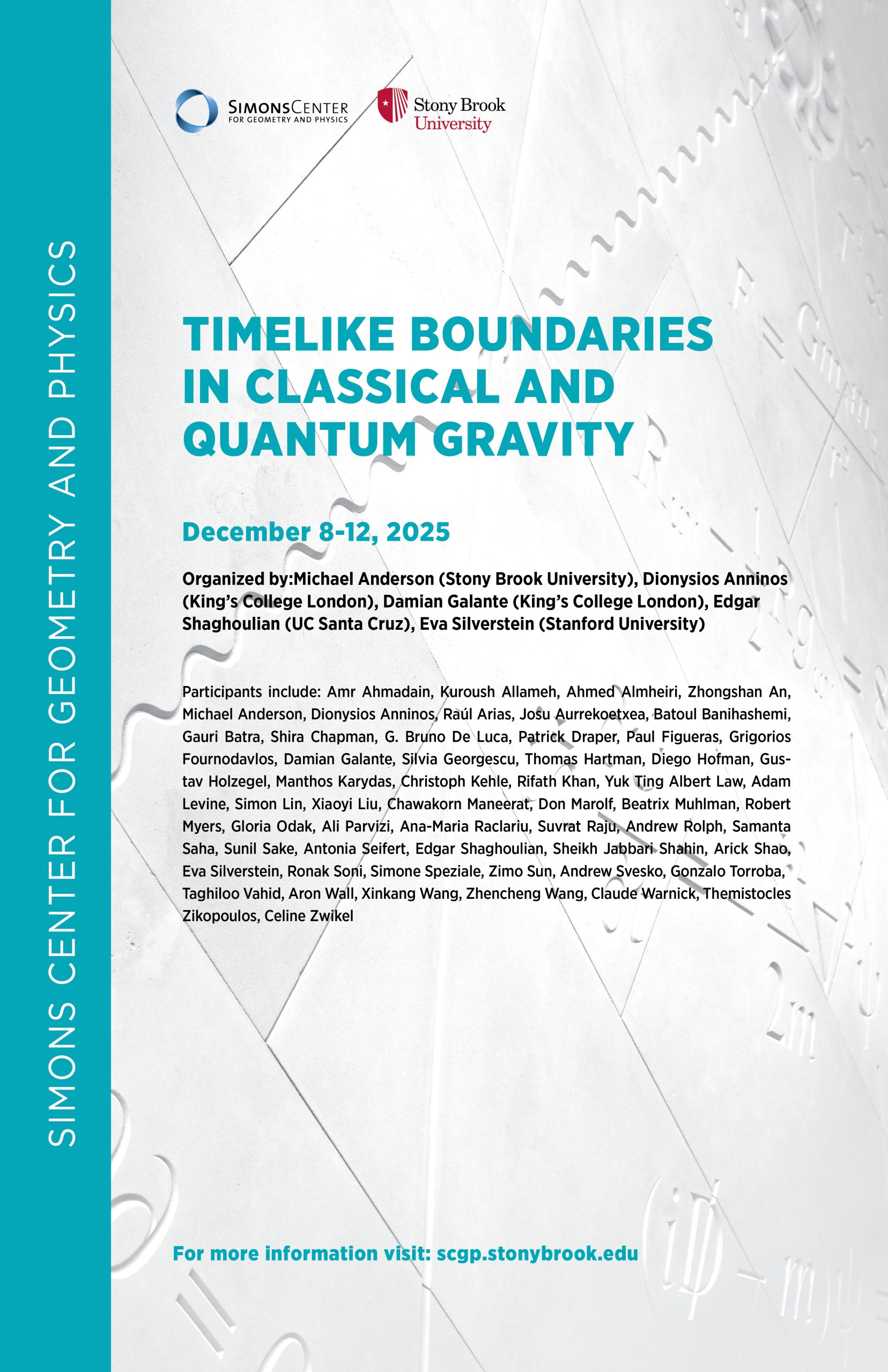Participant ListView VideosScheduleSHUTTLE SCHEDULE THE IBVP in quantum and classical gravitySTUDENT PRESENTATIONS INFO
Organized by:
- Michael Anderson (Stony Brook University)
- Dionysios Anninos (King’s College London)
- Damian Galante (King’s College London)
- Edgar Shaghoulian (UC Santa Cruz)
- Eva Silverstein (Stanford University)
Asymptotic boundaries play a crucial role in the theory of general relativity. Foundational examples include the null boundary of asymptotically flat spacetimes and the conformal boundary of Anti-de Sitter space. However, not all physical settings allow for such asymptotic boundaries. In cosmology the topology of spacetime is not known, and may contain finite timelike boundaries enabling a quasilocal holographic formulation capturing the microphysics of the cosmological horizon. Finite timelike boundaries can be considered in spacetimes with arbitrary cosmological constant, and they lead to a host of fascinating questions involving well-posedness, stability, and quantum-mechanical aspects. Building from recent progress on these problems, the workshop will focus on this rapidly developing area which lies at the interface between mathematics and theoretical physics.

| Time |
Title |
Speaker |
Location |
| 8:30am |
Breakfast |
N/A |
SCGP Cafe |
| 9:30am |
The initial boundary value problem for the Einstein vacuum equations with umbilic boundary |
Grigorios Fournodavlos |
SCGP 102 |
| 10:30am |
Coffee Break |
N/A |
SCGP Cafe |
| 11:00am |
Thermodynamics of gravity at finite cutoff |
Batoul Banihashemi |
SCGP 102 |
| 12:00pm |
Lunch |
N/A |
SCGP Cafe |
| 2:30pm |
Timelike Dirichlet Boundaries and the End of Time |
Don Marolf |
SCGP 102/ZOOM |
| 3:30pm |
Tea Time |
N/A |
SCGP Cafe |
| 4:00pm |
Quantum aspects of time-like boundaries |
Gonzalo Torroba (Discussion) |
SCGP 102 |
| Time |
Title |
Speaker |
Location |
| 8:30am |
Breakfast |
N/A |
SCGP Cafe |
| 9:30am |
Euclidean well-posedness and Lorentzian ill-posedness of generalized conformal boundary conditions |
Xiaoyi Liu |
SCGP 102 |
| 10:30am |
Coffee Break |
N/A |
SCGP Cafe |
| 11:00am |
A theory of two-sided de Sitter space with matter and the cosmological future wedge |
Gauri Batra |
SCGP 102 |
| 12:00pm |
Lunch |
N/A |
SCGP Cafe |
| 12:00pm |
Group Photo |
N/A |
SCGP Lobby |
| 2:30pm |
Timelike Liouville theory and AdS3 gravity at finite cutoff |
Kuroush Allameh |
SCGP 102 |
| 3:30pm |
Tea Time |
N/A |
SCGP Cafe |
| 4:00pm |
Discussion |
Chawakorn Maneerat/Andrew Svesko (Discussion) |
SCGP 102 |
| Time |
Title |
Speaker |
Location |
| 8:30am |
Breakfast |
N/A |
SCGP Cafe |
| 9:30am |
Geometric boundary conditions for the IBVP of vacuum Einstein equations |
Zhongshan An |
SCGP 102/ZOOM |
| 10:30am |
Coffee Break |
N/A |
SCGP Cafe |
| 11:00am |
Timelike boundaries in numerical relativity |
Pau Figueras |
SCGP 102 |
| 12:00pm |
Lunch |
N/A |
SCGP Cafe |
| 1:00pm |
Student presentations |
N/A |
SCGP 102 |
| 2:30pm |
Gravitational charge algebras with open boundary conditions |
Simone Speziale |
SCGP 102 |
| 3:30pm |
Tea Time |
N/A |
SCGP Cafe |
| 4:00pm |
Weak turbulence on Schwarzschild-AdS spacetime |
Christopher Kehle |
SCGP 102 |
| Time |
Title |
Speaker |
Location |
| 8:30am |
Breakfast |
N/A |
SCGP Cafe |
| 9:30am |
Towards an Algebra of Observables in String Theory |
Amr Ahmadain |
SCGP 102 |
| 10:30am |
Coffee Break |
N/A |
SCGP Cafe |
| 11:00am |
Conformal boundaries near cosmological horizo |
Silvia Georgescu |
SCGP 102 |
| 12:00pm |
Lunch |
N/A |
SCGP Cafe |
| 2:30pm |
Gravity on a finite region with fixed-area boundary conditions |
Tom Hartman |
SCGP 102 |
| 3:30pm |
Tea Time |
N/A |
SCGP Cafe |
| 4:00pm |
Towards Hamiltonian String Field Theory, and Dirichlet Walls |
Aron Wall |
SCGP 102 |
| 6:00pm |
Banquet |
N/A |
SCGP 102 |
| Time |
Title |
Speaker |
Location |
| 8:30am |
Breakfast |
N/A |
SCGP Cafe |
| 9:30am |
Gravity Is Induced By Renormalization Group Flow |
Vahid Taghiloo |
SCGP 102/ZOOM |
| 10:30am |
Coffee Break |
N/A |
SCGP Cafe |
| 11:00am |
Horizon Edge Modes in Λ > 0 Quantum Gravity |
Albert Law |
SCGP 102 |
| 12:00pm |
Lunch |
N/A |
SCGP Cafe |
| 2:30pm |
Covariant Phase Space for Boundaries with Corners: An Example of AdS$_4$ in Partial Bondi Gauge |
Celine Zwikel |
SCGP 102 |
| 3:30pm |
Tea Time |
N/A |
SCGP Cafe |
| 4:00pm |
A modern path integral approach to closed universes and the no-boundary proposal |
Adam Levine |
SCGP 102 |




